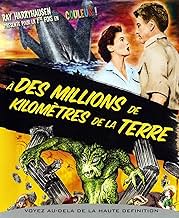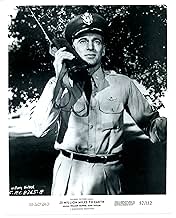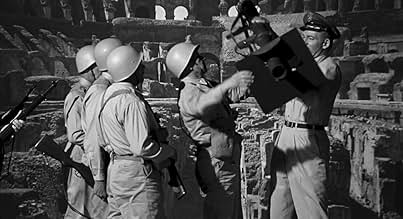VALUTAZIONE IMDb
6,3/10
8678
LA TUA VALUTAZIONE
La prima astronave Americana inviata su Venere atterra al largo della costa Siciliana, portando con se una mostruosa creatura simile ad una lucertola che diventa presto gigantesca.La prima astronave Americana inviata su Venere atterra al largo della costa Siciliana, portando con se una mostruosa creatura simile ad una lucertola che diventa presto gigantesca.La prima astronave Americana inviata su Venere atterra al largo della costa Siciliana, portando con se una mostruosa creatura simile ad una lucertola che diventa presto gigantesca.
- Regia
- Sceneggiatura
- Star
Thomas Browne Henry
- Maj. Gen. A.D. McIntosh
- (as Thomas B. Henry)
Bart Braverman
- Pepe
- (as Bart Bradley)
Sid Cassel
- Farmer
- (non citato nei titoli originali)
Neil Collins
- Technician
- (non citato nei titoli originali)
Paul Cristo
- Police Officer
- (non citato nei titoli originali)
Noel Drayton
- 1st Reuters News Correspondent
- (non citato nei titoli originali)
John Duke
- American Embassy Aide
- (non citato nei titoli originali)
Darlene Fields
- Miss Reynolds
- (non citato nei titoli originali)
Duke Fishman
- Fisherman
- (non citato nei titoli originali)
Michael Garth
- Minor Role
- (non citato nei titoli originali)
Ray Harryhausen
- Man Feeding Elephant
- (non citato nei titoli originali)
Recensioni in evidenza
Let's state the obvious right off the bat. If it weren't for the stop-motion animation in this film, it would be simply awful. Awful acting, awful script, mediocre direction, this film has it all.
But once the monster appears on screen, none of that matters. Ray Harryhausen's animation is, as always, simply spellbinding, giving the monster, paradoxically, both a heightened reality (as it really is a physical object photographed in "real life") and a dreamlike quality. It's easy to see how Harryhausen's work set the standards for monster special effects until Star Wars and computer animation came along many years later.
This film is a particularly good example of his work for a number of reasons. There's only one monster (unlike the Sinbad/Jason/Titans movies), so all his effort is spent on that one "character". The monster also starts out small and grows huge by the end of the movie, allowing us to see it in a variety of settings. And, the fact that it's a humanoid (rather than a dinosaur or big octopus) allows it to "act" in a much more expressive manner (not unlike the original Kong).
So while this movie may qualify as little more than "MST3K" fodder as a science fiction work (did I mention how truly awful the script is?), as a piece of animation, it's a pure classic, deserving a space on your shelf next to King Kong, Snow White and Fantasia.
But once the monster appears on screen, none of that matters. Ray Harryhausen's animation is, as always, simply spellbinding, giving the monster, paradoxically, both a heightened reality (as it really is a physical object photographed in "real life") and a dreamlike quality. It's easy to see how Harryhausen's work set the standards for monster special effects until Star Wars and computer animation came along many years later.
This film is a particularly good example of his work for a number of reasons. There's only one monster (unlike the Sinbad/Jason/Titans movies), so all his effort is spent on that one "character". The monster also starts out small and grows huge by the end of the movie, allowing us to see it in a variety of settings. And, the fact that it's a humanoid (rather than a dinosaur or big octopus) allows it to "act" in a much more expressive manner (not unlike the original Kong).
So while this movie may qualify as little more than "MST3K" fodder as a science fiction work (did I mention how truly awful the script is?), as a piece of animation, it's a pure classic, deserving a space on your shelf next to King Kong, Snow White and Fantasia.
Or should I say, Ray Harryhausen's creature IS the film. Compared to the creature, the human habitants here don't have a chance to emote and are only what one might charitably call "adequate" to the task.
WILLIAM HOPPER lacks the energy and personality he put into playing Paul Drake in all those "Perry Mason" TV movies. He appears to be almost immobilized and never changes his expression, even when the creature is doing maximum damage to the surroundings. JOAN TAYLOR is quite forgettable as "the girl", a woman who tells Hopper that she's "almost a doctor", when introducing herself. She's almost an actress too.
But nobody is going to give a whit about the acting in this sort of thing, so I'm happy to report that the frightful looking bit of slime that turns into a fast-growing creature with a human torso and scaly skin is extremely well animated by Harryhausen, who creates some very realistic looking fight scenes and displays of temper as the creature goes on the loose. There's an awful lot of screaming going on, both from the creature and the spectators who run into him.
Helpful too is the fact that this was filmed in Italy, where the action takes place, and there's a terrific climax shot in the Roman Coliseum where the creature finally meets his fate.
For the child in all of us, this is terrific fun--but just don't expect much from the human cast. The story is absurd and follows the usual sci-fi pattern of keeping you glued to your seat just to see how it all turns out.
WILLIAM HOPPER lacks the energy and personality he put into playing Paul Drake in all those "Perry Mason" TV movies. He appears to be almost immobilized and never changes his expression, even when the creature is doing maximum damage to the surroundings. JOAN TAYLOR is quite forgettable as "the girl", a woman who tells Hopper that she's "almost a doctor", when introducing herself. She's almost an actress too.
But nobody is going to give a whit about the acting in this sort of thing, so I'm happy to report that the frightful looking bit of slime that turns into a fast-growing creature with a human torso and scaly skin is extremely well animated by Harryhausen, who creates some very realistic looking fight scenes and displays of temper as the creature goes on the loose. There's an awful lot of screaming going on, both from the creature and the spectators who run into him.
Helpful too is the fact that this was filmed in Italy, where the action takes place, and there's a terrific climax shot in the Roman Coliseum where the creature finally meets his fate.
For the child in all of us, this is terrific fun--but just don't expect much from the human cast. The story is absurd and follows the usual sci-fi pattern of keeping you glued to your seat just to see how it all turns out.
This is a simple enough film. Rocket returning from Venus crashes near Sicily and a foetal thing grows to become a giant lizardy humanoid type thing. The acting is ordinary and the script predictable.
What makes it better than average for a 1950s monster movie is the Ray Harryhausen animated Venusian, called a Ymir here. Photographed in atmospheric black and white, its progress from small caged creature to being loose and dangerous on the streets of Rome and fighting an elephant is engrossing. You can't help rooting for the Ymir, attacked along the way by dogs and soldiers. The Ymir becomes a character like Frankenstein's creation or the Creature from the Black Lagoon. Excellent work by Harryhausen, and far more interesting than the CGI dinosaurs from Spielberg's over praised (and underwhelming) Jurassic Park trilogy.
What makes it better than average for a 1950s monster movie is the Ray Harryhausen animated Venusian, called a Ymir here. Photographed in atmospheric black and white, its progress from small caged creature to being loose and dangerous on the streets of Rome and fighting an elephant is engrossing. You can't help rooting for the Ymir, attacked along the way by dogs and soldiers. The Ymir becomes a character like Frankenstein's creation or the Creature from the Black Lagoon. Excellent work by Harryhausen, and far more interesting than the CGI dinosaurs from Spielberg's over praised (and underwhelming) Jurassic Park trilogy.
I have to admit I was drawn to this because it was set in Sicily, but they really never got far from Rome.
It is a significant film for the fact that special effects were done by Ray Harryhausen, who has a cameo in the film (watch for the man feeding the elephant at the zoo.).
William Hopper, who played Perry Mason's assistant Paul Drake, will be a familiar face for those who grew up during the 50's and 60's. Joan Taylor was also on TV a lot during those years. They both have a rich sci-fi history in films like Earth vs. the Flying Saucers, "Men Into Space", and Conquest of Space.
The little Godzilla-like monster from Venus is the focus of the film as they try to find and capture it. Of course, Hooper knows all about the creature when facing it. Such plot holes would raise howls of derision today, but it was common in the films of the 50's.
An enjoyable reach into the past with a film that entertains more than a lot of the DTV we see today.
It is a significant film for the fact that special effects were done by Ray Harryhausen, who has a cameo in the film (watch for the man feeding the elephant at the zoo.).
William Hopper, who played Perry Mason's assistant Paul Drake, will be a familiar face for those who grew up during the 50's and 60's. Joan Taylor was also on TV a lot during those years. They both have a rich sci-fi history in films like Earth vs. the Flying Saucers, "Men Into Space", and Conquest of Space.
The little Godzilla-like monster from Venus is the focus of the film as they try to find and capture it. Of course, Hooper knows all about the creature when facing it. Such plot holes would raise howls of derision today, but it was common in the films of the 50's.
An enjoyable reach into the past with a film that entertains more than a lot of the DTV we see today.
This movie is a prime example of the work of one of the masters of stop-motion animation, a form of art that is rapidly being supplanted by CGI. Ray Harryhausen was the ultimate master of this technique, having trained under the likes of Willis O'Brian. His work is still the inspiration for many of the special effects wizards today. Granted, the movies of the 1950's do seem stilted and silly, but quite frankly, the worst of them are probably still superior to most of the direct-to-video drek produced today, and likely better than most of the films produced by major studios. I was raised on films such as 20 Million Miles to Earth and have no problem letting my child watch films like this. I cannot say the same for most of what is released today. 20 Million Miles to Earth is a unique, fun film. It, like others of its kind, comes from a different era, when people were not as jaded and world-savvy as they are today. Save the critical eye for the more cynical, overproduced films of today. Enjoy it for what it is.
Lo sapevi?
- QuizThe film was originally going to be set in Chicago, with the rocket crashing in Lake Michigan. Right before submitting the idea to producer Charles H. Schneer, Ray Harryhausen decided to change the setting to Italy at the last minute, after deciding that he always wanted to go on vacation there.
- BlooperThe spaceship crashes into the water no more than 100 yards from the fishermen. Yet their boats are in no way affected by any disturbance of the water. A vessel that large crashing into the water would have created a large wake that would have at the least rocked the boats heavily, if not capsized them.
- Citazioni
Dr. Judson Uhl: You better tell them we're in a hurry and to roll up the red tape and put it into a drawer until this thing is over!
- Curiosità sui creditiOpening credits prologue: A FISHING VILLAGE IN SICILY
- Versioni alternativeMany local TV stations delete the scene in which the Ymir kills an elephant from a zoo, claiming the scene is a needless depiction of cruelty to animals.
- ConnessioniEdited from Ultimatum alla Terra (1951)
I più visti
Accedi per valutare e creare un elenco di titoli salvati per ottenere consigli personalizzati
- How long is 20 Million Miles to Earth?Powered by Alexa
Dettagli
- Data di uscita
- Paesi di origine
- Lingue
- Celebre anche come
- A 30 milioni di Chilometri dalla Terra
- Luoghi delle riprese
- Azienda produttrice
- Vedi altri crediti dell’azienda su IMDbPro
- Tempo di esecuzione
- 1h 22min(82 min)
- Colore
- Proporzioni
- 1.85 : 1
Contribuisci a questa pagina
Suggerisci una modifica o aggiungi i contenuti mancanti



































